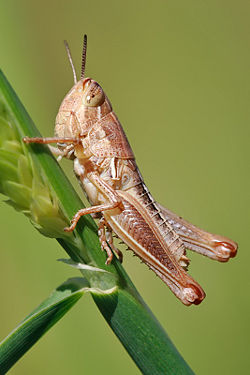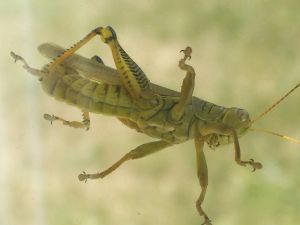Difference between revisions of "Caelifera" - New World Encyclopedia
Rick Swarts (talk | contribs) |
Rick Swarts (talk | contribs) |
||
| Line 61: | Line 61: | ||
Locusts are several species of [[short-horned grasshopper]]s of the family [[Acrididae]] that sometimes form very large groups (swarms); these can be highly destructive and migrate in a more or less coordinated way. Thus, these grasshoppers have solitary and gregarious (swarm) phases. Locust swarms can cause massive damage to [[agriculture|crops]]. Important locust species include ''[[Schistocerca gregaria]]'' and ''[[Locusta migratoria]]'' in Africa and the Middle East, and ''[[Schistocerca piceifrons]]'' in tropical Mexico and Central America ([[Mesoamerica]]). Other grasshoppers important as pests (which, unlike true locusts, do not change colour when they form swarms) include ''[[Melanoplus]]'' species (like ''M. bivittatus'', ''M. femurrubrum'' and ''M. differentialis'') and ''[[Camnula pellucida]]'' in North America; the [[lubber grasshopper]] ''[[Brachystola magna]]'', and ''[[Sphenarium purpurascens]]'' in Northern and Central Mexico; species of ''[[Rhammatocerus]]'' in South America; and the [[Senegalese grasshopper]] ''Oedaleus senegalensis'' and the [[variegated grasshopper]] ''Zonocerus variegatus'' in Africa. | Locusts are several species of [[short-horned grasshopper]]s of the family [[Acrididae]] that sometimes form very large groups (swarms); these can be highly destructive and migrate in a more or less coordinated way. Thus, these grasshoppers have solitary and gregarious (swarm) phases. Locust swarms can cause massive damage to [[agriculture|crops]]. Important locust species include ''[[Schistocerca gregaria]]'' and ''[[Locusta migratoria]]'' in Africa and the Middle East, and ''[[Schistocerca piceifrons]]'' in tropical Mexico and Central America ([[Mesoamerica]]). Other grasshoppers important as pests (which, unlike true locusts, do not change colour when they form swarms) include ''[[Melanoplus]]'' species (like ''M. bivittatus'', ''M. femurrubrum'' and ''M. differentialis'') and ''[[Camnula pellucida]]'' in North America; the [[lubber grasshopper]] ''[[Brachystola magna]]'', and ''[[Sphenarium purpurascens]]'' in Northern and Central Mexico; species of ''[[Rhammatocerus]]'' in South America; and the [[Senegalese grasshopper]] ''Oedaleus senegalensis'' and the [[variegated grasshopper]] ''Zonocerus variegatus'' in Africa. | ||
| − | |||
| − | |||
| − | |||
| − | |||
| − | |||
| − | |||
| − | |||
| − | |||
| − | |||
| − | |||
| − | |||
| − | |||
| − | |||
==Media== | ==Media== | ||
Revision as of 02:16, 16 November 2008
| Caelifera
| ||||||||||||
|---|---|---|---|---|---|---|---|---|---|---|---|---|
 Immature grasshopper
| ||||||||||||
| Scientific classification | ||||||||||||
| ||||||||||||
|
Caelifera is a suborder of the order Orthoptera, comprising "short-horned" orthopterans with the common names of grasshoppers and locusts, characterized in extant members by saltorial hind limbs (modified for leaping), antennae having less than 30 segments, and the absence of auditory organs on the prothorax. Although members of Caelifera are sometimes collectively known as grasshoppers, often this designation is limited to the "true grasshoppers" of the caeliferan family Acrididae and the term short-horned grasshoppers is used for members of the suborder to distinguish them from the "long-horned grasshoppers" of the orthopteran suborder Ensifera. The term locusts is not a taxonomic grouping but rather is applied to caeliferan species that exhibit a behavioral, morphological, and physiological shift from a solitary phase to a gregarious migratory phase.
In many places around the world, grasshoppers are eaten as a good source of protein. In Mexico for example chapulines are used as a snack or filling. It is found on skewers in Chinese food markets, like the Donghuamen Night Market [1]
Raw grasshoppers should be eaten with caution, as they can contain tapeworms.[2]
Overview and description
As members of the insect order Orthoptera, caeliferans are characterized by chewing/biting mouthparts, incomplete metamorphosis (hemimetabolism), strong hind limbs, and two pairs of wings that are held overlapping the abdomen at rest. The forewings are narrower than the hindwings and hardened at the base, while the hindwings are membranous and folded fan-like under the forewings when at rest.
Orthoptera includes two suborders, Caelifera (short-horned grasshoppers and locusts) and Ensifera (crickets, katydids, and weta). The Ensifera, sometimes collectively known as "long-horned grasshoppers" (Naskrecki 2004), are typified by antennae with many more than 30 segments and longer than the body, while the Caelifera have antennae shorter than the body. In evolutionary terms, the split between the Caelifera and the Ensifera is no more recent than the Permo-Triassic boundary (Zeuner 1939).
Characteristics of Caelifera include having a short ovipositor in females that has four functional valves (versus the typically six-valved, sword-shaped ovipositor of female ensiferans); antennae with less than 30 segments; and if a hearing organ is present, such as a tympanum, it is found on the abdomen, on the sides of the first abdominal segment. Generally they are winged, but hind wings are membranous while front wings (tegmina) are coriaceous and not fit for flight. Females are normally larger than males. Males have a single unpaired plate at the end of the abdomen. Females have two pairs of valves ( triangles) at the end of the abdomen used to dig in sand when egg laying.
Those species that make easily heard noises usually do so by rubbing the hind femurs against the forewings or abdomen (stridulation), or by snapping the wings in flight. This is different from the ensiferans who rub their tegmina against each other, with one tegmen (front wing) being a modified vein (the file) that is equipped with a file-like row of teeth, and this is rubbed against a modified vein, making a hardened edge, of the second tegmen (the scraper).
The presence of the protein resilin in the back legs of grasshoppers is one reason that some can make repeated leaps of long distance, perhaps 8.5 feet (2.6 meters), without any sign of fatigue. Resilin has remarkable elastic properties, with 97 percent efficiency in returning stored energy, and allows a release of energy beyond that of muscle power alone (Naskrecki 2004).
Habitat, behavior, and reproduction

The Caelifera are predominantly tropical but most of the superfamilies are represented world wide.
Classification
Recent estimates (Kevan 1982; Günther, 1980, 1992; Otte 1994-1995; subsequent literature) indicate some 2,400 valid Caeliferan genera and about 11,000 valid species described to date. Many undescribed species exist, especially in tropical wet forests.
Locusts
See also locust.
Locusts are several species of short-horned grasshoppers of the family Acrididae that sometimes form very large groups (swarms); these can be highly destructive and migrate in a more or less coordinated way. Thus, these grasshoppers have solitary and gregarious (swarm) phases. Locust swarms can cause massive damage to crops. Important locust species include Schistocerca gregaria and Locusta migratoria in Africa and the Middle East, and Schistocerca piceifrons in tropical Mexico and Central America (Mesoamerica). Other grasshoppers important as pests (which, unlike true locusts, do not change colour when they form swarms) include Melanoplus species (like M. bivittatus, M. femurrubrum and M. differentialis) and Camnula pellucida in North America; the lubber grasshopper Brachystola magna, and Sphenarium purpurascens in Northern and Central Mexico; species of Rhammatocerus in South America; and the Senegalese grasshopper Oedaleus senegalensis and the variegated grasshopper Zonocerus variegatus in Africa.
Media
- Tettigoniid Camouflage Aug2008.jpg
Camouflage
- Grasshopper front-side view.JPG
Grasshopper front side view
See also
ReferencesISBN links support NWE through referral fees
- Firefly Encyclopedia of Insects and Spiders, edited by Christopher O'Toole, ISBN 1-55297-612-2, 2002
- Gwynne, D. T. and L. DeSutter. 1996. Ensifera. Crickets, katydids and weta. Tree of Life Web Project Version 01 January 1996. Retrieved November 10, 2008.
- Gwynne, D. T., L. DeSutter, P. Flook, and H. Rowell. 1996. Orthoptera. Crickets, kaytdids, grasshoppers, etc.. Tree of Life Web Project Version 01 January 1996. Retrieved November 10, 2008.
- Naskrecki, P. 2004. Orthoptera. In B. Grzimek, D. G. Kleiman, V. Geist, and M. C. McDade, Grzimek's Animal Life Encyclopedia. Detroit: Thomson-Gale. ISBN 0787657883.
- Rowell, H., and P. Flook. 2001. Caelifera. Shorthorned Grasshoppers, Locusts and Relatives. Tree of Life Web Project version March 23, 2001. Retrieved November 15, 2008.
External links
- Tree of Life Web Project
- The Grasshopper suicide
- American grasshopper on the UF / IFAS Featured Creatures Web site
Credits
New World Encyclopedia writers and editors rewrote and completed the Wikipedia article in accordance with New World Encyclopedia standards. This article abides by terms of the Creative Commons CC-by-sa 3.0 License (CC-by-sa), which may be used and disseminated with proper attribution. Credit is due under the terms of this license that can reference both the New World Encyclopedia contributors and the selfless volunteer contributors of the Wikimedia Foundation. To cite this article click here for a list of acceptable citing formats.The history of earlier contributions by wikipedians is accessible to researchers here:
The history of this article since it was imported to New World Encyclopedia:
Note: Some restrictions may apply to use of individual images which are separately licensed.



